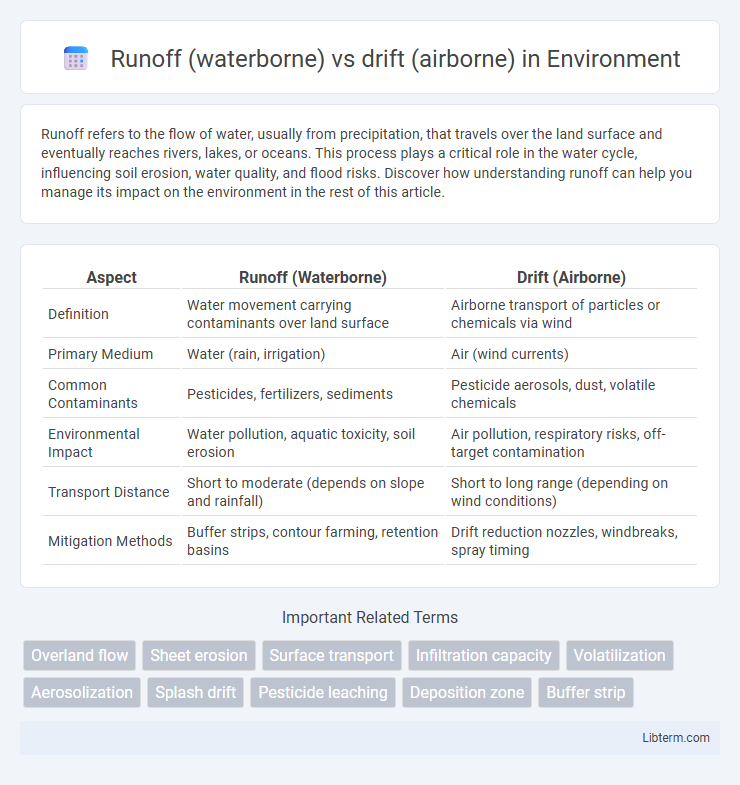Runoff refers to the flow of water, usually from precipitation, that travels over the land surface and eventually reaches rivers, lakes, or oceans. This process plays a critical role in the water cycle, influencing soil erosion, water quality, and flood risks. Discover how understanding runoff can help you manage its impact on the environment in the rest of this article.
Table of Comparison
| Aspect | Runoff (Waterborne) | Drift (Airborne) |
|---|---|---|
| Definition | Water movement carrying contaminants over land surface | Airborne transport of particles or chemicals via wind |
| Primary Medium | Water (rain, irrigation) | Air (wind currents) |
| Common Contaminants | Pesticides, fertilizers, sediments | Pesticide aerosols, dust, volatile chemicals |
| Environmental Impact | Water pollution, aquatic toxicity, soil erosion | Air pollution, respiratory risks, off-target contamination |
| Transport Distance | Short to moderate (depends on slope and rainfall) | Short to long range (depending on wind conditions) |
| Mitigation Methods | Buffer strips, contour farming, retention basins | Drift reduction nozzles, windbreaks, spray timing |
Understanding Waterborne Runoff
Waterborne runoff occurs when precipitation or irrigation water flows over the soil surface, carrying pesticides, fertilizers, and other contaminants into nearby water bodies. This process contributes significantly to the pollution of rivers, lakes, and groundwater through the transport of nutrients and chemicals. Understanding the factors influencing waterborne runoff, such as soil type, slope, rainfall intensity, and land management practices, is essential for developing effective strategies to minimize environmental impact.
Defining Airborne Drift
Airborne drift refers to the tiny pesticide droplets or particles that become suspended in the air during or after application, traveling beyond the target area through wind or air currents. Unlike runoff, which involves waterborne movement of chemicals into nearby soil or water bodies, airborne drift poses risks to non-target plants, animals, and human health due to its wide dispersal potential. Understanding the factors influencing airborne drift, such as droplet size, wind speed, and application techniques, is critical for minimizing environmental contamination and ensuring effective pesticide use.
Key Differences: Runoff vs Drift
Runoff refers to waterborne movement of pesticides or pollutants across soil surfaces into water bodies, influenced by factors such as rainfall intensity, soil type, and slope gradient. Drift involves airborne transport of pesticide droplets or particles during or immediately after application, primarily affected by wind speed, droplet size, and spray equipment. Key differences lie in their transport medium--water for runoff and air for drift--and their environmental pathways, which determine distinct contamination risks for aquatic and non-target terrestrial ecosystems.
Environmental Impacts of Runoff
Runoff from agricultural fields carries pesticides and fertilizers into nearby water bodies, causing nutrient pollution, algal blooms, and aquatic ecosystem disruption. Contaminated runoff contributes to the degradation of water quality, threatening aquatic life and human health through bioaccumulation of toxic chemicals. Managing runoff requires implementing buffer zones, soil conservation practices, and controlled irrigation to minimize environmental contamination and protect freshwater resources.
Environmental Impacts of Drift
Drift, or airborne pesticide particles, disperses contaminants beyond target zones, causing widespread environmental harm including air pollution and damage to non-target plants and aquatic ecosystems. Unlike runoff, which primarily affects soil and water bodies through surface movement, drift contributes to atmospheric contamination and respiratory risks for humans and wildlife. Effective management of drift is critical to minimizing ecological disruption and ensuring pesticide application safety.
Factors Influencing Runoff and Drift
Runoff and drift are influenced by distinct factors impacting their movement and environmental effects. Runoff is primarily affected by soil type, slope gradient, rainfall intensity, and ground cover, which determine the volume and speed of waterborne pesticide movement. Drift depends largely on nozzle type, spray pressure, wind speed, temperature, and humidity, all of which influence the airborne pesticide particles' dispersion and distance traveled.
Human Health Risks: Runoff vs Drift
Runoff from agricultural fields carries pesticides and contaminants directly into water bodies, increasing risks of waterborne diseases and toxic exposure for nearby populations. Drift disperses fine airborne pesticide particles, posing inhalation hazards that can trigger respiratory problems, allergic reactions, and long-term chronic health effects in exposed communities. Both exposure pathways demand strict management to minimize contaminant spread and protect human health from acute and chronic toxicities.
Mitigation Strategies for Waterborne Runoff
Mitigation strategies for waterborne runoff primarily involve implementing vegetative buffer strips, constructing retention basins, and adopting best management practices (BMPs) like controlled fertilizer application to reduce pollutant transport into surface waters. Techniques such as contour farming and permeable pavement improve soil infiltration and minimize runoff volume. Stormwater management systems are designed to capture and treat runoff, preventing contaminants from entering aquatic ecosystems.
Control Methods for Airborne Drift
Airborne drift control methods include using low-drift nozzles that produce larger droplets, adjusting spray pressure to minimize fine droplet formation, and applying sprays during low wind conditions to reduce off-target movement. Employing buffer zones and barriers can physically block or slow airborne particles, enhancing containment. Technology such as drift-reducing agents and precision application systems further optimize spray deposition while minimizing environmental contamination.
Regulatory Guidelines and Best Practices
Regulatory guidelines for runoff and drift control emphasize minimizing environmental contamination through targeted mitigation strategies. Runoff management requires practices such as buffer zones, soil stabilization, and proper timing of pesticide applications to prevent waterborne pollutants from reaching surface waters. Drift control prioritizes using low-drift nozzles, adjusting spray pressure, and adhering to wind speed limits to reduce airborne pesticide dispersion and comply with EPA and state regulations.
Runoff (waterborne) Infographic

 libterm.com
libterm.com